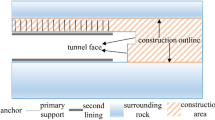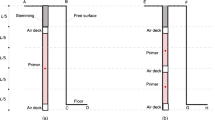Abstract
The charge structure in the cutting area has an important practical engineering significance in improving the blasting performance and increasing the excavation work efficiency, especially in tunneling practices with soft and broken surrounding rocks. To contain the excessive damage in the tunnel face of the Meishan Iron Mine, the finite element program LS-DYNA is used to investigate the effect of the charge structure of cutting holes (with an air deck and without an air deck at the blasthole bottom) on the blasting performance in roadway excavation. Numerical results indicated that the blasthole bottom was seriously damaged by blasting under the condition of charge without an air deck. Accordingly, 80-mm bottom air deck length is determined based on analytical calculation, and a numerical simulation was conducted and showed that the air deck could effectively weaken the excessive damage around the blasthole bottom. Specifically, the peak pressure at the monitoring point (10 cm horizontally from the center of the blasthole bottom) with an air deck is 22.1 MPa, which is much smaller than that of the no-air-deck case of 207.1 MPa. The field experimental results indicated that the tunnel face was obviously damaged under the condition of holes without an air deck and the tunnel face was relatively flat under the condition of a blasthole bottom with an air deck, which is consistent with the numerical results. The workload for cleaning loose rock for the next excavation cycle in a 3.5 m advance was reduced from 40 min to around 25 min.

















Similar content being viewed by others
Data availability
The datasets generated during and/or analysed during the current study are available from the corresponding author on reasonable request.
References
Arshadnejad S (2019) Design of hole pattern in static rock fracture process due to expansion pressure. Int J Rock Mech Min 123:104100. https://doi.org/10.1016/j.ijrmms.2019.104100
Balakrishnan V, Pradhan M, Dhekne PY (2020) Investigating rock fragmentation in distributed spherical air-gap blasting technique. Powder Technol 362:101–110. https://doi.org/10.1016/j.powtec.2019.11.110
Chen ZB, Cheng LY, Zhong MS, Xu QJ, Wen ZL, Sun F (2017) Bottom inert medium in deck charging blasting experiment. Eng Blasting 23(1):12–15. https://doi.org/10.3969/j.issn.1006-7051.2017.01.003
Chen D, Sun C, Wang L (2021a) Collapse behavior and control of hard roofs in steeply inclined coal seams. Bull Eng Geol Environ 80(2):1489–1505. https://doi.org/10.1007/s10064-020-02014-3
Chen M, Wei D, Yi CP, Lu WB, Johansson D (2021b) Failure mechanism of rock mass in bench blasting based on structural dynamics. Bull Eng Geol Environ 80(9):6841–6861. https://doi.org/10.1007/s10064-021-02324-0
Chen Y, Chen J, Wang P, Zhou M, Yang H, Li J (2021c) Design method of blasthole charge structure based on lithology distribution. Sci Rep 11(1):24247. https://doi.org/10.1038/s41598-021-03758-y
Ding CX, Yang RS, Lei Z, Wang M, Zhao Y, Lin H (2021) Fractal damage and crack propagation in decoupled charge blasting. Soil Dyn Earthq Eng 141:106503. https://doi.org/10.1016/j.soildyn.2020.106503
Esen S, Onederra I, Bilgin HA (2003) Modelling the size of the crushed zone around a blasthole. Int J Rock Mech Min 40(4):485–495. https://doi.org/10.1016/S1365-1609(03)00018-2
Hallquist JO (2007) LS-DYNA keyword user’s manual. Livermore Software Technology Corporation 970:299–800
Jang H, Topal E (2013) Optimizing overbreak prediction based on geological parameters comparing multiple regression analysis and artificial neural network. Tunn Undergr Space Technol 38:161–169. https://doi.org/10.1016/j.tust.2013.06.003
Jang H, Handel D, Ko Y, Yang H-S, Miedecke J (2018) Effects of water deck on rock blasting performance. Int J Rock Mech Min 112:77–83. https://doi.org/10.1016/j.ijrmms.2018.09.006
Jeong H, Jeon B, Choi S, Jeon S (2020) Fracturing behavior around a blasthole in a brittle material under blasting loading. Int J Impact Eng 140:103562. https://doi.org/10.1016/j.ijimpeng.2020.103562
Jhanwar JC (2011) Theory and practice of air-deck blasting in mines and surface excavations: a review. Geotech Geol Eng 29(5):651–663. https://doi.org/10.1007/s10706-011-9425-x
Jhanwar JC, Cakraborty AK, Anireddy HN, Jethwa JL (1999) Application of air decks in production blasting to improve fragmentation and economics of an open pit mine. Geotech Geol Eng 17(1):37–57. https://doi.org/10.1023/A:1008899928839
Lee E, Finger M, Collins W (1973) JWL equation of state coefficients for high explosives. Lawrence Livermore National Lab. (LLNL), Livermore, CA (United States)
Li HB, Xia X, Li JC, Zhao J, Liu B, Liu YQ (2011) Rock damage control in bedrock blasting excavation for a nuclear power plant. Int J Rock Mech Min 48(2):210–218. https://doi.org/10.1016/j.ijrmms.2010.11.016
Li Y, Huang C, Liu L, Chen X, Zhao Q (2021) Experimental and numerical investigation on the explosive characteristics of slotted cartridges under different slotted structures. Rock Mech Rock Eng 54(12):6173–6189. https://doi.org/10.1007/s00603-021-02592-y
Lin DY, Wang CG, Deng JH (1989) Analysis of the blasting effects and results of bottom air cushion loading. Nonferrous Metals 41(4):1–6
Liu KW, Li XD, Hao H, Li XB, Sha YY, Wang WH, Liu XL (2019) Study on the raising technique using one blast based on the combination of long-hole presplitting and vertical crater retreat multiple-deck shots. Int J Rock Mech Min Sci 113:41–58. https://doi.org/10.1016/j.ijrmms.2018.11.012
Lou XM, Zhou P, Yu J, Sun MW (2020) Analysis on the impact pressure on blast hole wall with radial air-decked charge based on shock tube theory. Soil Dyn Earthq Eng 128:105905. https://doi.org/10.1016/j.soildyn.2019.105905
LSTC (2003) LS-DYNA keyword user’s manual. Livermore Software Technology Corporation
Lu WB, Leng ZD, Hu HR, Chen M, Wang GH (2018) Experimental and numerical investigation of the effect of blast-generated free surfaces on blasting vibration. Eur J Environ Sci 22(11):1374–1398. https://doi.org/10.1080/19648189.2016.1262285
Mel’Nikov N (1940) Utilisation of energy of explosives and fragment size of rock in blasting operations. Gorn Zh 5:1
Park D, Jeon S (2010) Reduction of blast-induced vibration in the direction of tunneling using an air-deck at the bottom of a blasthole. Int J Rock Mech Min 47(5):752–761. https://doi.org/10.1016/j.ijrmms.2010.04.011
Peng JY, Zhang FP, Du C, Yang XH (2020) Effects of confining pressure on crater blasting in rock-like materials under electric explosion load. Int J Impact Eng 139:103534. https://doi.org/10.1016/j.ijimpeng.2020.103534
Riedel W, Thoma K, Hiermaier S, Schmolinske E (1999) Penetration of reinforced concrete by BETA-B-500 numerical analysis using a new macroscopic concrete model for hydrocodes. Proceedings of the 9th International Symposium on the Effects of Munitions with Structures, Berlin-Strausberg Germany
Riedel W, Kawai N, Kondo K-i (2009) Numerical assessment for impact strength measurements in concrete materials. Int J Impact Eng 36(2):283–293. https://doi.org/10.1016/j.ijimpeng.2007.12.012
Shadab Far M, Wang Y (2016) Probabilistic analysis of crushed zone for rock blasting. Comput Geotech 80:290–300. https://doi.org/10.1016/j.compgeo.2016.08.025
Silva J, Worsey T, Lusk B (2019) Practical assessment of rock damage due to blasting. Int J Min Sci Technol 29(3):379–385. https://doi.org/10.1016/j.ijmst.2018.11.003
Wang ZL, Konietzky H (2009) Modelling of blast-induced fractures in jointed rock masses. Eng Fract Mech 76(12):1945–1955. https://doi.org/10.1016/j.engfracmech.2009.05.004
Wang ZK, Gu XW, Zhang WL, Xie QK, Xu XC, Wang Q (2019) Analysis of the cavity formation mechanism of wedge cut blasting in hard rock. Shock Vib 2019:1828313. https://doi.org/10.1155/2019/1828313
Wang J, Zhang Y, Qin Z, Song SG, Lin P (2020a) Analysis method of water inrush for tunnels with damaged water-resisting rock mass based on finite element method-smooth particle hydrodynamics coupling. Comput Geotech 126:103725. https://doi.org/10.1016/j.compgeo.2020.103725
Wang Y, Wen Z, Liu G, Wang J, Bao Z, Lu K, Wang D, Wang B (2020) Explosion propagation and characteristics of rock damage in decoupled charge blasting based on computed tomography scanning. Int J Rock Mech Min 136:104540. https://doi.org/10.1016/j.ijrmms.2020.104540
Wu L, Lu WB, Zong Q (2006) Distribution of explosive energy consumed by column charge in rock. Rock Soil Mech 27(5):735–739. https://doi.org/10.16285/j.rsm.2006.05.010
Xia WJ, Lu WB, Li RZ, Chen M, Lei Z (2020) Effect of water-decked blasting on rock fragmentation energy. Shock Vib 2020:8194801. https://doi.org/10.1155/2020/8194801
Xie LX, Lu WB, Zhang QB, Jiang QH, Chen M, Zhao J (2017) Analysis of damage mechanisms and optimization of cut blasting design under high in-situ stresses. Tunn Undergr Space Technol 66:19–33. https://doi.org/10.1016/j.tust.2017.03.009
Yang JX, Liu CY, Yu B (2017) Application of confined blasting in water-filled deep holes to control strong rock pressure in hard rock mines. Energies 10(11):1874. https://doi.org/10.3390/en10111874
Yang C, Zhou KP, Li ZC, Xiong X, Lin Y, Luo ZW (2020) Numerical modeling on the fracturing and energy evolution of large deep underground openings subjected to dynamic disturbance. Energies 13(22):6102. https://doi.org/10.3390/en13226102
Yang C, Zhou KP, Gao RG, Xiong X (2021) Numerical investigation of the dynamic response of a preconditioned roof in an underground mine: a case study of mining environment regeneration. Soil Dyn Earthq Eng 140:106457. https://doi.org/10.1016/j.soildyn.2020.106457
Ye ZY, Pan K, Zhou ZH (2020) Onsite tests and numerical simulation of broken rock zones in surrounding rocks of seepage roadways under blasting. Geofluids 2020:8893449. https://doi.org/10.1155/2020/8893449
Yi CP, Johansson D, Greberg J (2018) Effects of in-situ stresses on the fracturing of rock by blasting. Comput Geotech 104:321–330. https://doi.org/10.1016/j.compgeo.2017.12.004
Zhang Q, He M, Wang J, Guo S, Guo Z, Liu X, Hu J, Ma Z, Fan L, Guo P (2020) Instantaneous expansion with a single fracture: a new directional rock-breaking technology for roof cutting. Int J Rock Mech Min 132:104399. https://doi.org/10.1016/j.ijrmms.2020.104399
Zhang SH, Gao WX, Ye MB, Liu JC, Liu LS, Li XS, Hu Y (2021) Dynamic response characteristics of a rock slope under blasting excavation. Bull Eng Geol Environ 80(11):8453–8464. https://doi.org/10.1007/s10064-021-02442-9
Zhang Q, He MC, Guo S, Qi JC, Yang J, Wang C, Xia M, Li LN (2022a) Investigation on the key techniques and application of the new-generation automatically formed roadway without coal pillars by roof cutting. Int J Rock Mech Min 152:105058. https://doi.org/10.1016/j.ijrmms.2022.105058
Zhang Q, Tao ZG, Yang C, Guo S, Mc He, Zhang CY, Niu HY, Wang C, Wang S (2022b) Experimental and numerical investigation into the non-explosive excavation of tunnels. J Rock Mech Geotech Eng. https://doi.org/10.1016/j.jrmge.2022.02.003
Zhou ST, Luo XD, Jiang N, Zhang ST, Lei Y (2021) Ground vibration characteristics of carbon dioxide phase transition fracturing: an in situ test. Bull Eng Geol Environ 80(12):9029–9047. https://doi.org/10.1007/s10064-021-02479-w
Funding
This work was supported by the National Natural Science Foundation of China (Grant No. 52204167); the Hunan Provincial Natural Science Foundation of China (Grant No. 2020JJ4704); and the 14th Five-Year Plan for National Key Research & Development Program of China (Grant No. 2020YFC1909801); The corresponding author gives his gratitude to the financial support of China Scholarship Council.
Author information
Authors and Affiliations
Corresponding author
Rights and permissions
Springer Nature or its licensor (e.g. a society or other partner) holds exclusive rights to this article under a publishing agreement with the author(s) or other rightsholder(s); author self-archiving of the accepted manuscript version of this article is solely governed by the terms of such publishing agreement and applicable law.
About this article
Cite this article
Gao, F., Tang, L., Yang, C. et al. Blasting-induced rock damage control in a soft broken roadway excavation using an air deck at the blasthole bottom. Bull Eng Geol Environ 82, 97 (2023). https://doi.org/10.1007/s10064-023-03087-6
Received:
Accepted:
Published:
DOI: https://doi.org/10.1007/s10064-023-03087-6




